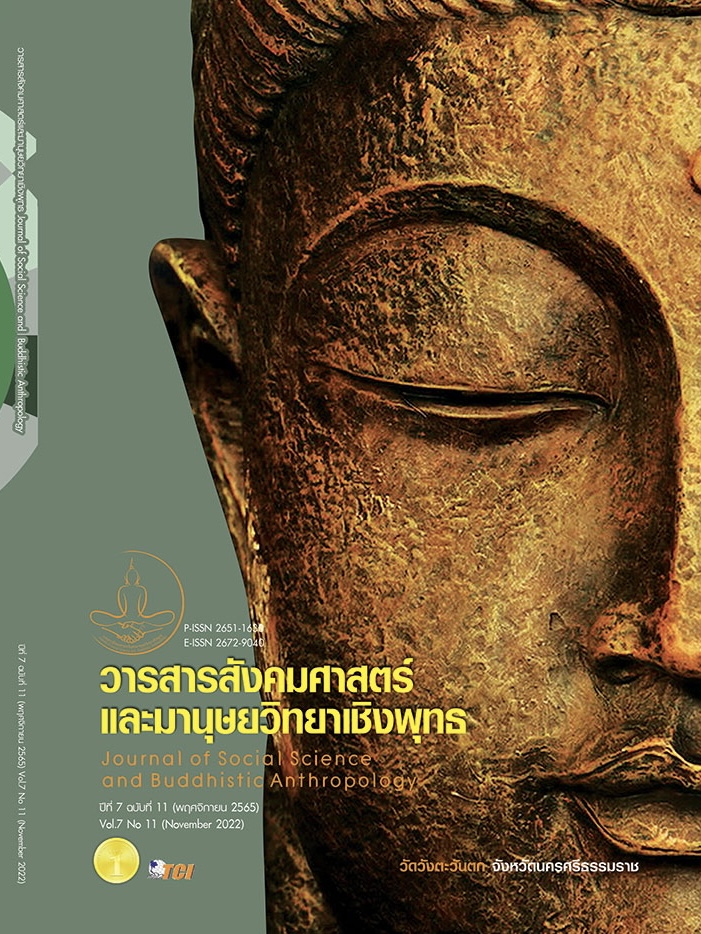THE STUDY OF PERCEPTION AND CONCEPTUAL PHOTOGRAPHING PROCEDURES FROM A CONTEMPORARY ART: PINK MAN, MANIT SRIWANICHBHUMI
Keywords:
Contemporary Art, Conceptual Photography, A Photographic Work of Pink ManAbstract
The objectives of this research article were to 1) study problems in contemporary art history, theoretical concepts, and conceptual interpretations of conceptual photography in Thailand, and 2) study and analyze the concept and process of Manit Sriwanichpoom's contemporary art work series, "Pink Man". Documents, related research, academic journals, and interviews were used to collect data for this qualitative research, in which the content specified in the objectives was analyzed with description. The research reveals that 1) conceptual photography in Thailand involved the creation of photographic works based on the social context, or story, that the artist wished to convey through the planning process of the creation in order to respond to the concept in order to achieve aesthetic beauty by using signs as remarks to create interest in the photograph and using modern technology through computerized processes to embellish and create perfection. Beauty might not be found in the finished process of the work; however, the artist's narrative was quite compelling from the beginning of the conceptual process to the point of completion; 2) the analysis of Manit Sriwanichpoom's photography work series, "Pink Man," in terms of the conceptual photography process, theory application, and practice guidelines indicated that the artist created this photography work series based on the concept of consumerism in Thai society, using sarcasm to portray society's classes and social values in Thai society at different times, using symbols that conflict with the image of society as a whole, in which the artist wished that the audience would see the photograph and follow the artist’s concept, which was intended to raise awareness and care among people in society.
References
กฤษฏิญา ไชยศรี. (2565). Contemporary Art ศิลปะร่วมสมัยที่เกิดขึ้นในยุคปัจจุบัน (แต่ดันเข้าใจยากกว่ายุคที่ผ่านมา). เรียกใช้เมื่อ 8 พฤศจิกายน 2565 จาก https://ground controlth.com/blogs/art-term-contemporary-art
กฤษณะ บุญเทียน และศุภรัก สุวรรณวัจน์ . (2560). การสร้างสรรค์ผลงานภาพถ่ายที่สื่อถึงความสงบตามแนวความคิดของพระพุทธศาสนา. วารสารวิชาการศิลปะสถาปัตยกรรมศาสตร์มหาวิทยาลัยนเรศวร, 8(2), 106-119.
กาญจนา แก้วเทพ และคณะ. (2555). สื่อเก่า-สื่อใหม่: สัญญะ อัตลักษณ์ อุดมการณ์. กรุงเทพมหานคร: ภาพพิมพ์.
ธนกิจ โคกทอง และคณะ. (2557). การสร้างสรรค์ศิลปะภาพถ่ายภาพ ดิจิทัลเพื่อส่งเสริมการขายสินค้าแฟชั่นผ่านเฟสบุ๊ค. วารสารวิชาการศิลปะสถาปัตยกรรมศาสตร์มหาวิทยาลัยนเรศวร, 5(1), 26-40.
ภาณุ บุญพิพัฒนาพงศ์. (2560). ART IS ART, ART IS NOT ART อะไร (แม่ง) ก็เป็นศิลปะ. กรุงเทพมหานคร: สำนักพิมพ์ Salmon Book.
ภาณุ บุญพิพัฒนาพงศ์. (2564). ART and POLITIC. Conceptual Art ศิลปะแห่งความคิดที่ละทิ้งความงามและต่อต้านความสูงส่ง. เรียกใช้เมื่อ 8 พฤษภาคม 2565 จาก https://themomen tum.co/conceptual-art/
วิบูลย์ ลี้สุวรรณ. (2548). ศิลปะในประเทศไทย:จากศิลปะโบราณในสยามถึงศิลปะสมัยใหม่. กรุงเทพมหานคร: ศูนย์หนังสือลาดพร้าว.
ศรศักดิ์ ศักดิ์บดินทร์. (2559). Conceptual Photography. เรียกใช้เมื่อ 24 พฤษภาคม 2565 จาก https://fotofaka.com/conceptual-photography/
สิทธิธรรม โรหิตะสุข. (2564). พัฒนาการทางความคิดและการสร้างสรรค์ในศิลปะร่วมสมัยไทย. กรุงเทพมหานคร: สันติศิริการพิมพ์.
สุธี คุณาวิชยานนท์. (2546). จากสยามเก่าสู่ไทยใหม่ว่าด้วยความพลิกผันจากประเพณีสู่สมัยใหม่ละร่วมสมัย. (พิมพ์ครั้งที่ 2). กรุงเทพมหานคร: บ้านหัวแหลม.
สุธี คุณาวิชยานนท์. (2563). ทัศนศิลป์ไทยสมัยใหม่-ร่วมสมัย. กรุงเทพมหานคร: สำนักพิมพ์จุฬาลงกรณ์มหาวิทยาลัย.
อัษฎา โปราณานนท์. (2556). คุณลักษณะของการถ่ายภาพ (Characteristics of Photography). วารสารอารยะธรรมศึกษาโขง-สาละวินมหาวิทยาลัยนเรศวร, 4(1), 73-90.
Downloads
Published
How to Cite
Issue
Section
License
Copyright (c) 2022 Journal of Social Science and Buddhistic Anthropology

This work is licensed under a Creative Commons Attribution-NonCommercial-NoDerivatives 4.0 International License.








